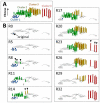Constructive Approaches for Understanding the Origin of Self-Replication and Evolution
- PMID: 27420098
- PMCID: PMC5041002
- DOI: 10.3390/life6030026
Constructive Approaches for Understanding the Origin of Self-Replication and Evolution
Abstract
The mystery of the origin of life can be divided into two parts. The first part is the origin of biomolecules: under what physicochemical conditions did biomolecules such as amino acids, nucleotides, and their polymers arise? The second part of the mystery is the origin of life-specific functions such as the replication of genetic information, the reproduction of cellular structures, metabolism, and evolution. These functions require the coordination of many different kinds of biological molecules. A direct strategy to approach the second part of the mystery is the constructive approach, in which life-specific functions are recreated in a test tube from specific biological molecules. Using this approach, we are able to employ design principles to reproduce life-specific functions, and the knowledge gained through the reproduction process provides clues as to their origins. In this mini-review, we introduce recent insights gained using this approach, and propose important future directions for advancing our understanding of the origins of life.
Keywords: constructive approach; evolution; in vitro system; self-replication system.
Conflict of interest statement
The authors declare no conflict of interest.
Figures




Similar articles
-
Constructing partial models of cells.Cold Spring Harb Perspect Biol. 2010 Jun;2(6):a004945. doi: 10.1101/cshperspect.a004945. Epub 2010 Apr 28. Cold Spring Harb Perspect Biol. 2010. PMID: 20516136 Free PMC article. Review.
-
How evolution builds up complexity?: In vitro evolution approaches to witness complexification in artificial molecular replication systems.Biophys Physicobiol. 2022 Feb 15;19:1-10. doi: 10.2142/biophysico.bppb-v19.0005. eCollection 2022. Biophys Physicobiol. 2022. PMID: 35435608 Free PMC article.
-
A modular hierarchy-based theory of the chemical origins of life based on molecular complementarity.Acc Chem Res. 2012 Dec 18;45(12):2169-77. doi: 10.1021/ar200209k. Epub 2012 Feb 27. Acc Chem Res. 2012. PMID: 22369101
-
The RNA World and its origins.Planet Space Sci. 1995 Jan-Feb;43(1-2):161-5. doi: 10.1016/0032-0633(94)00166-o. Planet Space Sci. 1995. PMID: 11538430
-
Sex in a test tube: testing the benefits of in vitro recombination.Philos Trans R Soc Lond B Biol Sci. 2016 Oct 19;371(1706):20150529. doi: 10.1098/rstb.2015.0529. Philos Trans R Soc Lond B Biol Sci. 2016. PMID: 27619693 Free PMC article. Review.
Cited by
-
Translation activity of chimeric ribosomes composed of Escherichia coli and Bacillus subtilis or Geobacillus stearothermophilus subunits.Biochem Biophys Rep. 2017 May 12;10:325-328. doi: 10.1016/j.bbrep.2017.05.002. eCollection 2017 Jul. Biochem Biophys Rep. 2017. PMID: 28955760 Free PMC article.
-
Automated in vitro evolution of a translation-coupled RNA replication system in a droplet flow reactor.Sci Rep. 2018 Aug 8;8(1):11867. doi: 10.1038/s41598-018-30374-0. Sci Rep. 2018. PMID: 30089835 Free PMC article.
-
Self-replication of circular DNA by a self-encoded DNA polymerase through rolling-circle replication and recombination.Sci Rep. 2018 Aug 30;8(1):13089. doi: 10.1038/s41598-018-31585-1. Sci Rep. 2018. PMID: 30166584 Free PMC article.
-
Applications of phage-derived RNA-based technologies in synthetic biology.Synth Syst Biotechnol. 2020 Dec;5(4):343-360. doi: 10.1016/j.synbio.2020.09.003. Epub 2020 Oct 16. Synth Syst Biotechnol. 2020. PMID: 33083579 Free PMC article. Review.
-
Is Research on "Synthetic Cells" Moving to the Next Level?Life (Basel). 2018 Dec 26;9(1):3. doi: 10.3390/life9010003. Life (Basel). 2018. PMID: 30587790 Free PMC article.
References
-
- Gesteland T.R.C.R., Atkins J.F. RNA World: The Nature of Modern RNA Suggests a Prebiotic RNA World. Cold Spring Harbor Laboratory Press; New York, NY, USA: 2005.
Publication types
LinkOut - more resources
Full Text Sources
Other Literature Sources

